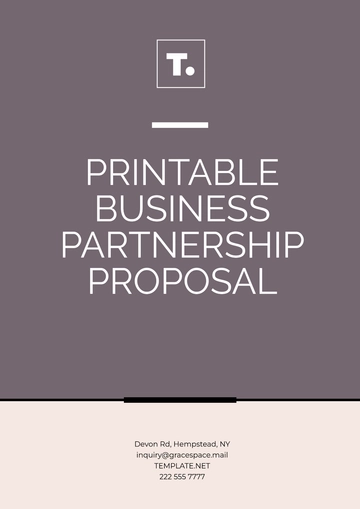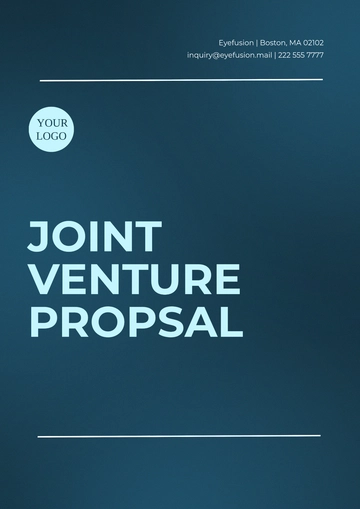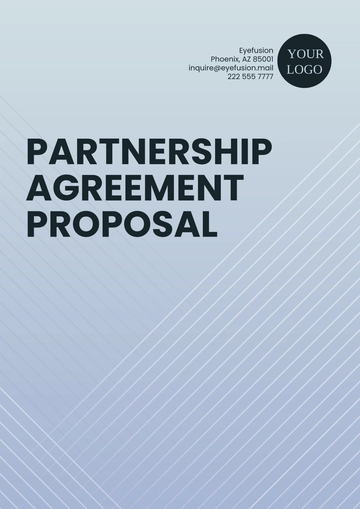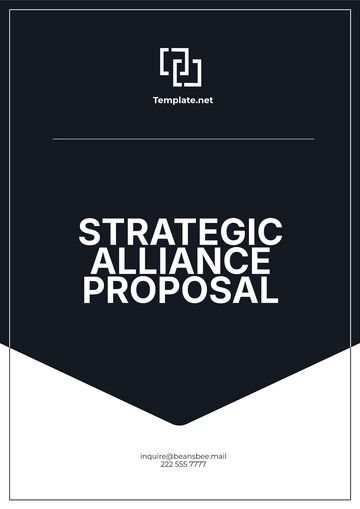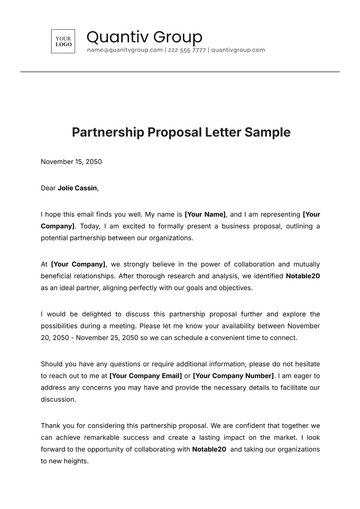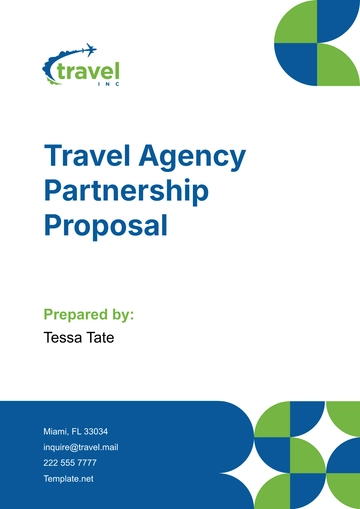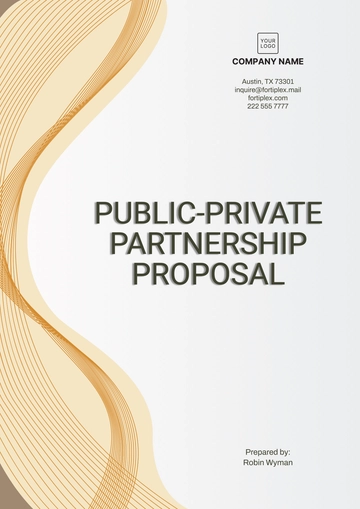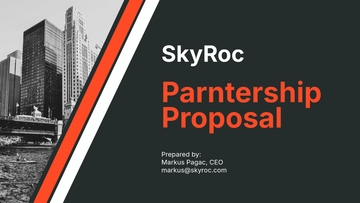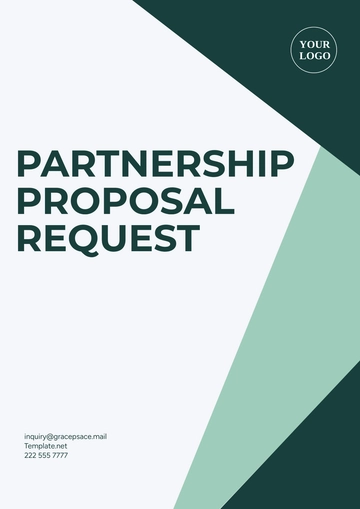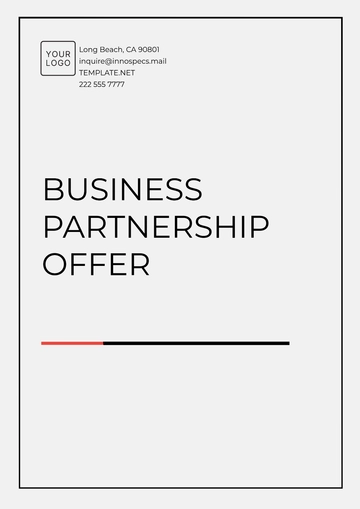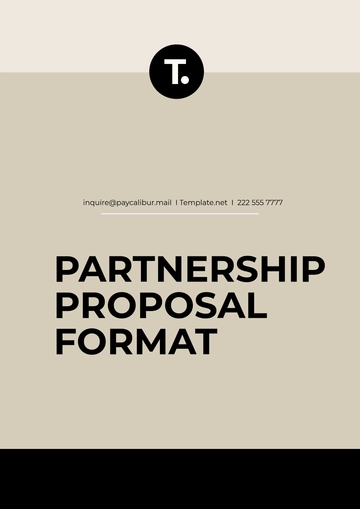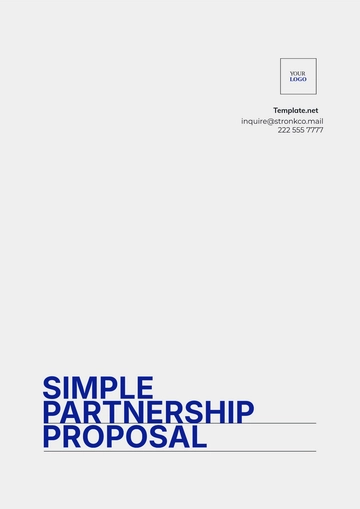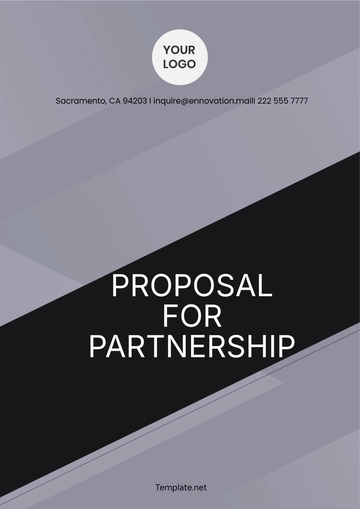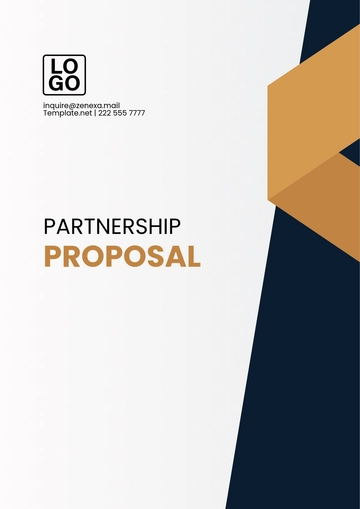Free Hotel Partnership Proposal
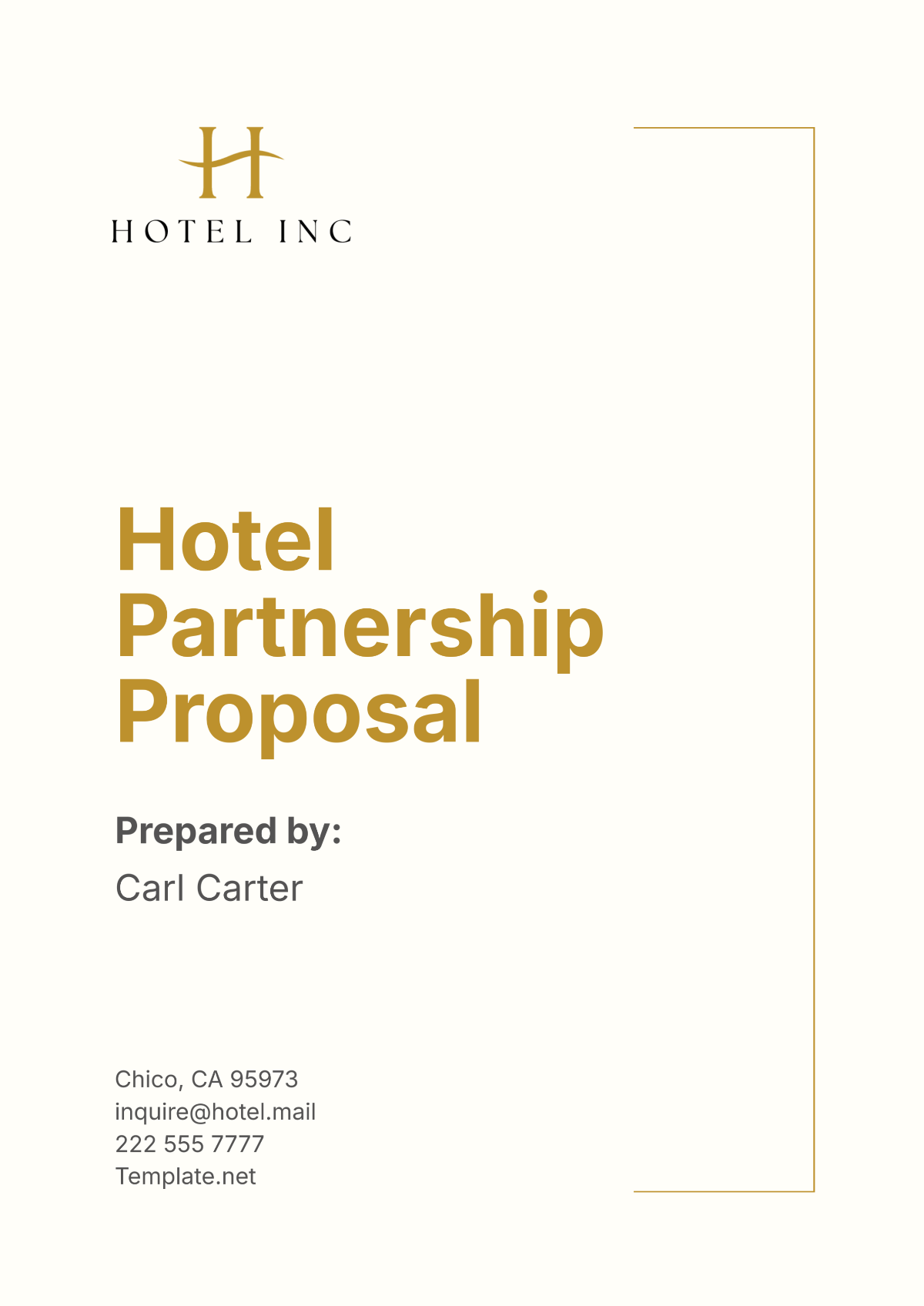
Prepared By: [Your Name]
I. Overview
This proposal seeks to establish a mutually beneficial partnership between [Your Company Name] and Castorias. We envision this partnership as a collaborative effort that will provide significant benefits to both parties. The primary aim is to leverage the strengths of each organization to achieve common goals and enhance customer satisfaction.
II. Specific Objectives
The partnership between [Your Company Name] and Castorias is designed to achieve several specific objectives that will benefit both organizations:
Enhance Brand Visibility and Market Reach: By collaborating, both organizations can leverage each other's brand presence and marketing channels to increase visibility and reach a broader audience, ultimately strengthening brand awareness and recognition in the market.
Increase Customer Engagement and Loyalty: Through joint marketing initiatives and collaborative campaigns, we aim to deepen customer engagement and loyalty. By offering unique promotions and experiences, we can create more meaningful connections with our customers, fostering loyalty and repeat business.
Develop and Implement Joint Promotional Campaigns: Together, we will create and execute joint promotional campaigns that highlight the strengths and unique offerings of both companies. These campaigns will not only attract new customers but also showcase the value of our partnership to existing customers, encouraging them to continue patronizing our services.
Innovate New Service Offerings: By combining our expertise and resources, we have the opportunity to innovate and develop new service offerings that capitalize on the strengths of both organizations. These new offerings will provide added value to our customers and differentiate us from competitors in the market.
Optimized Operational Efficiency: Streamline operational processes, improve resource utilization, and enhance efficiency through shared resources, standardized procedures, and collaborative problem-solving.
Achieving these objectives will have a positive impact on both partners, allowing us to better serve our customers, drive growth, and enhance profitability. Through this partnership, we are confident that we can create lasting value for our organizations and strengthen our positions in the market.
III. Proposed Partnership Model
The partnership between [Your Company Name] and Castorias is built on a collaborative framework that fosters mutual growth. Our proposed partnership model encompasses the following key components:
Collaborative Marketing Strategies: We will jointly develop and execute marketing strategies that leverage the unique strengths and attributes of both brands. By combining our resources and expertise, we can create impactful campaigns that resonate with our target audience, increase brand awareness, and drive customer engagement.
Resource Sharing and Expertise Exchange: Both organizations will actively share resources, knowledge, and best practices to enhance service offerings and operational efficiency. This may include sharing industry insights, technology solutions, and training programs to empower teams and deliver exceptional experiences to our customers.
Co-branded Customer Engagement Initiatives: To foster customer loyalty and retention, we will implement co-branded events, promotions, and initiatives that provide added value to our customers. By offering unique experiences and exclusive benefits, we can strengthen our relationship with customers and differentiate ourselves in the market.
Performance Monitoring and Review Mechanisms: Clear performance metrics will be established to evaluate the effectiveness of our partnership initiatives. Regular review meetings will be conducted to assess progress, identify areas for improvement, and make necessary adjustments to optimize our collaborative efforts in alignment with our shared goals and objectives.
This partnership model is designed to foster a culture of collaboration, innovation, and continuous improvement. By working together closely and leveraging each other's strengths, we can achieve greater success and create lasting value for both organizations and our customers.
IV. Benefits to Castorias
As a valued partner, Castorias stands to gain several significant benefits from our collaboration:
Benefits | Description |
|---|---|
Enhanced Brand Visibility | Your brand will be prominently featured in all joint marketing campaigns and promotions, increasing exposure and brand recognition. |
Access to New Markets | Leveraging our established customer base, you will have the opportunity to introduce your products and services to new potential customers and markets. |
Shared Expertise | Gain valuable insights and expertise from our seasoned professionals, enabling you to innovate and enhance your service offerings. |
Increased Customer Loyalty | Collaborative initiatives will help foster a deeper connection with customers, leading to increased loyalty, retention, and lifetime value. |
Expected Impact:
By capitalizing on these benefits, Castoriascan expects to achieve the following outcomes:
Expanded Market Reach: The collaborative efforts between [Your Company Name] and Castorias will facilitate access to new markets and customers through joint initiatives. By combining resources and expertise, we can enter new markets and expand your customer base.
Enhanced Reputation: The partnership will elevate your brand visibility and credibility within the industry. Castorias will gain exposure and positive associations through joint marketing, boosting reputation, attracting new customers, and enhancing stakeholder trust and loyalty.
Improved Competitive Edge: Collaborating with [Your Company Name] will provide Your Partner Company Name with a distinct competitive advantage. By uniting our strengths and resources, Castorias delivers unique customer experiences, stays competitive, adapts to market trends, and strengthens its market position.
We are confident that these benefits will significantly contribute to the growth and success of Castorias, aligning with your strategic business objectives and strengthening our partnership for mutual benefit.
V. Communication and Collaboration Framework
Effective communication and collaboration are essential for the success of our partnership. This section outlines the communication and collaboration framework:
Communication Channels
Establish Clear Channels: Set up designated channels for communication, such as email, instant messaging platforms, and scheduled meetings, to ensure regular updates and discussions.
Utilize Collaboration Tools: Implement project management platforms and shared documents to facilitate seamless collaboration and information sharing among team members.
Regular Communication: Encourage consistent communication to keep all stakeholders informed about project progress, milestones, and any relevant updates or changes.
Feedback Mechanism: Create a feedback loop where stakeholders can provide input, suggestions, and concerns, fostering a culture of open communication and continuous improvement.
Stakeholder Engagement
Identify Key Stakeholders: Identify and involve key stakeholders from both organizations who have a vested interest in the partnership's success.
Promote Inclusivity: Ensure that all stakeholders have a voice and are actively engaged in decision-making processes, regardless of their position or role.
Transparency and Accountability: Foster transparency by sharing information openly and holding stakeholders accountable for their roles and contributions.
Regular Updates: Provide regular updates and progress reports to stakeholders to keep them engaged and informed about the partnership's activities and achievements.
Decision-Making Processes
Define Decision-Making Authority: Clearly define decision-making roles and responsibilities, specifying who has the authority to make decisions at each level of the partnership.
Establish Decision Criteria: Establish criteria for making informed decisions, considering factors such as project objectives, timelines, resource availability, and potential impact on stakeholders.
Timely Decision-Making: Ensure that decision-making processes are efficient and timely to prevent delays in project execution and maintain momentum.
Documentation: Document decisions and the rationale behind them to ensure transparency and provide a reference point for future discussions or evaluations.
Conflict Resolution Mechanisms
Proactive Conflict Management: Implement proactive measures to prevent conflicts from escalating, such as clear communication, establishing common goals, and promoting a collaborative culture.
Open Dialogue: Encourage open and honest communication among stakeholders to address conflicts as they arise, fostering mutual understanding and empathy.
Mediation and Facilitation: Utilize mediation techniques and facilitation skills to help parties in conflict find mutually acceptable solutions and resolve disagreements amicably.
Escalation Protocols: Define escalation protocols for unresolved conflicts, outlining steps for escalating issues to higher management or seeking external mediation if necessary.
By implementing a robust communication and collaboration framework, we can enhance trust, transparency, and synergy between our organizations, driving the success of our partnership.
VI. Timeline
The proposed timeline outlines key phases and activities to be undertaken to ensure successful collaboration between [Your Company Name] and Castorias.
Activities | Start Date | End Date |
|---|---|---|
Kickoff Meeting | [Month Day, Year] | [Month Day, Year] |
Partnership Plan Development | [Month Day, Year] | [Month Day, Year] |
Joint Marketing Campaigns | [Month Day, Year] | [Month Day, Year] |
Cross-Promotional Activities | [Month Day, Year] | [Month Day, Year] |
Training and Development Workshops | [Month Day, Year] | [Month Day, Year] |
Performance Review Meetings | [Month Day, Year] | [Month Day, Year] |
Strategy Refinement | [Month Day, Year] | [Month Day, Year] |
VII. Budget Allocation
The partnership timeline and budget offer a framework for planning collaboration with Castorias, outlining estimated financial resources needed for initiatives.
Category | Allocation |
|---|---|
Marketing and Promotion | $50,000 |
Training and Development | $20,000 |
Operational Costs | $30,000 |
Miscellaneous | $10,000 |
Total Estimated Budget | $110,000 |
The timeline ensures a smooth transition from initiation to implementation with clear milestones. Regular reviews will evaluate and adjust strategies for alignment with objectives and effective resource use.
VIII. Sustainability Commitment
As responsible corporate citizens, [Your Company Name] and Castorias are committed to sustainability and corporate social responsibility. This section highlights our shared commitment to sustainable practices:
Environmental Stewardship: Implement environmentally sustainable practices to minimize our ecological footprint and contribute to conservation efforts. This includes reducing energy consumption, minimizing waste generation, and promoting responsible resource management.
Social Responsibility: Demonstrate a commitment to social responsibility by supporting local communities, fostering diversity and inclusion, and promoting ethical business practices. Engage in philanthropic initiatives, volunteer programs, and partnerships that address social challenges and promote positive societal impact.
Ethical Standards: Uphold high ethical standards in all aspects of our operations, including transparency, integrity, and respect for human rights. Adhere to ethical business practices, codes of conduct, and industry regulations to maintain trust and credibility with stakeholders.
Continuous Improvement: Commit to continuous improvement in sustainability performance by setting measurable goals, tracking key performance indicators, and regularly reviewing and updating sustainability initiatives. Embrace innovation and collaboration to drive positive change and achieve long-term sustainability objectives.
By integrating sustainability into our partnership, we can create shared value for our organizations, stakeholders, and the environment, while also setting an example for responsible business practices in the industry.
IX. Next Steps
To progress with this partnership, we recommend the following steps:
Schedule an Initial Kickoff Meeting: Arrange a kickoff meeting to introduce key stakeholders from both organizations and discuss partnership details. This meeting will provide an opportunity to align objectives, clarify expectations, and establish a framework for collaboration.
Develop a Detailed Partnership Plan: Collaboratively develop a comprehensive partnership plan outlining specific initiatives, timelines, and responsibilities. This plan will serve as a roadmap for executing joint activities and ensuring accountability throughout the partnership.
Identify and Allocate Necessary Resources: Identify the resources required to support partnership activities, including personnel, budget, and technology. Allocate these resources effectively to facilitate smooth implementation and maximize the partnership's impact.
Launch First Joint Initiative and Commence Regular Reviews: Initiate the first joint initiative outlined in the partnership plan and schedule regular performance reviews to evaluate progress and alignment. These reviews will allow us to course-correct as needed and ensure that the partnership remains on track to achieve its objectives.
We are eager to embark on this collaborative journey with Castorias and are committed to ensuring its success.
X. Conclusion
The partnership between [Your Company Name] and Castorias presents a compelling opportunity to leverage our collective strengths, drive mutual growth, and create value for our organizations and stakeholders. We are excited about the potential of this partnership and are committed to fostering collaboration, innovation, and sustainable practices in all our endeavors. Thank you for considering this proposal. We look forward to the opportunity to collaborate and embark on this exciting journey together.
- 100% Customizable, free editor
- Access 1 Million+ Templates, photo’s & graphics
- Download or share as a template
- Click and replace photos, graphics, text, backgrounds
- Resize, crop, AI write & more
- Access advanced editor
Forge strong partnerships with the Hotel Partnership Proposal Template, available exclusively on Template.net. This fully editable and customizable template offers persuasive designs to outline partnership benefits, roles, and terms. With easy editing capabilities in our Ai Editor Tool, create proposals that build mutually beneficial relationships and enhance business opportunities.
You may also like
- Business Proposal
- Research Proposal
- Proposal Request
- Project Proposal
- Grant Proposal
- Photography Proposal
- Job Proposal
- Budget Proposal
- Marketing Proposal
- Branding Proposal
- Advertising Proposal
- Sales Proposal
- Startup Proposal
- Event Proposal
- Creative Proposal
- Restaurant Proposal
- Blank Proposal
- One Page Proposal
- Proposal Report
- IT Proposal
- Non Profit Proposal
- Training Proposal
- Construction Proposal
- School Proposal
- Cleaning Proposal
- Contract Proposal
- HR Proposal
- Travel Agency Proposal
- Small Business Proposal
- Investment Proposal
- Bid Proposal
- Retail Business Proposal
- Sponsorship Proposal
- Academic Proposal
- Partnership Proposal
- Work Proposal
- Agency Proposal
- University Proposal
- Accounting Proposal
- Real Estate Proposal
- Hotel Proposal
- Product Proposal
- Advertising Agency Proposal
- Development Proposal
- Loan Proposal
- Website Proposal
- Nursing Home Proposal
- Financial Proposal
- Salon Proposal
- Freelancer Proposal
- Funding Proposal
- Work from Home Proposal
- Company Proposal
- Consulting Proposal
- Educational Proposal
- Construction Bid Proposal
- Interior Design Proposal
- New Product Proposal
- Sports Proposal
- Corporate Proposal
- Food Proposal
- Property Proposal
- Maintenance Proposal
- Purchase Proposal
- Rental Proposal
- Recruitment Proposal
- Social Media Proposal
- Travel Proposal
- Trip Proposal
- Software Proposal
- Conference Proposal
- Graphic Design Proposal
- Law Firm Proposal
- Medical Proposal
- Music Proposal
- Pricing Proposal
- SEO Proposal
- Strategy Proposal
- Technical Proposal
- Coaching Proposal
- Ecommerce Proposal
- Fundraising Proposal
- Landscaping Proposal
- Charity Proposal
- Contractor Proposal
- Exhibition Proposal
- Art Proposal
- Mobile Proposal
- Equipment Proposal
- Student Proposal
- Engineering Proposal
- Business Proposal

